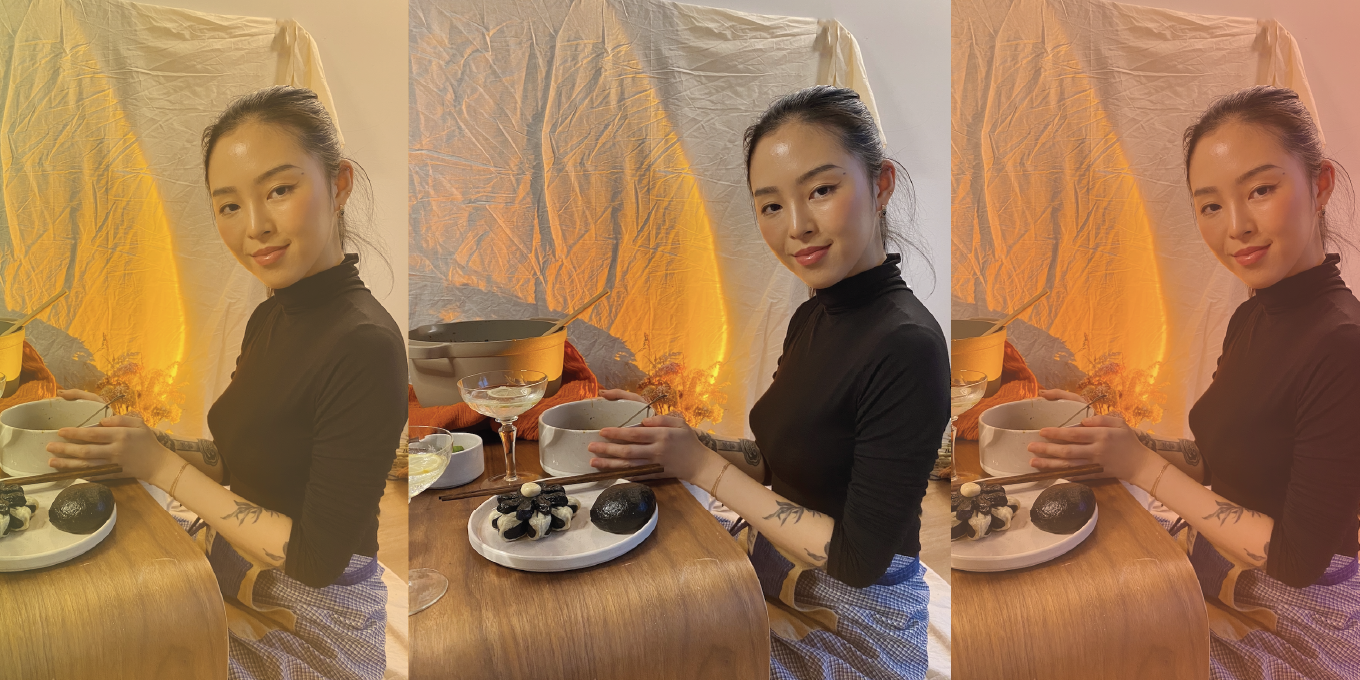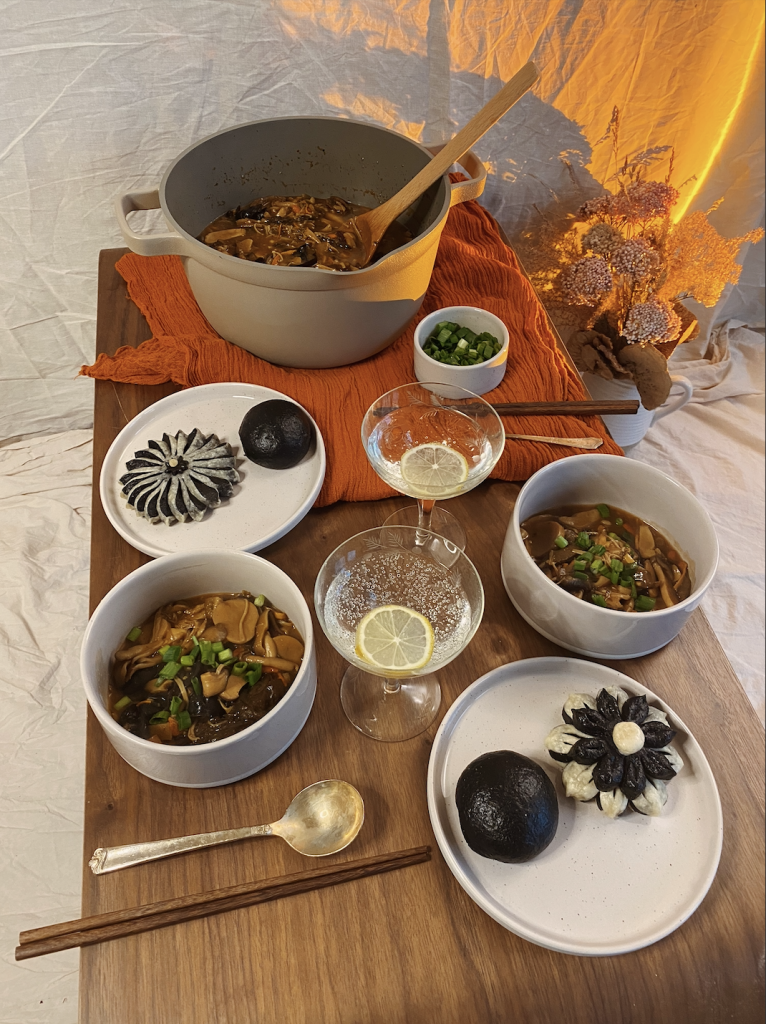Food & Drink
Traditional Chinese Medicine Chef and Nutritionist Zoey Gong Wants to Make You Feel Warm and Fuzzy
Gong shares her unique outlook on healing, embracing yourself and a yummy recipe that will make you hungry.
by : ELLE Canada- Feb 4th, 2022

Courtesy of Our Place/Zoey Gong
January has been the ultimate symbol of a fresh start, and we have nothing against this annual reminder to recenter and reconnect with ourselves. But modern expectations of ‘new year, new me’ drive us further from ourselves, often hinge on shame, and divorce us from our ancient, grounded ways of being.
Food and the rituals that surround it are sources of liberation, not guilt, and often we have to look back in) order to move forward. Homeware company Our Place (known for their iconic Always Pan) has embraced the tried, true and rooted ways of our ancestors in January and beyond. From passed-down recipes for nourishing meals to healing intergenerational trauma though cooking, they are sharing the foods traditions and wisdoms that have carried generations into many new years.
Case in point: Traditional Chinese Medicine chef and nutritionist Zoey Gong has a unique outlook on healing— she embraces the past, present, and future, while encouraging variety (both in food and in rituals) to ground yourself. As part of Our Place’s series, The Way We Heal, Gong shares her most important practises, plus she shared a fun Mushroom Stew and Black Sesame Bun recipe that will give you that warm and fuzzy feeling upon first taste.
What does healing mean to you?
On the surface, healing is to cure a wound, a chronic ailment, an emotional blockage. Deep down, healing is to embrace whatever we have and learn to transform our suffering, mental or physical, into something better than what we experienced a moment ago. It is about understanding who we are, who our ancestors are. From there, we can start to explore the different paths of healing that are unique to each of us.
What’s the best advice you have received from an elder?
Happiness is the most important [thing], [which was] from my grandparents.
What foods, spices, herbs are especially healing to you?
I appreciate all foods, spices, and herbs. I think the variety of them that we consume is the key for wellness. Most of us tend to eat a quite limited diet with only a few kinds of whole plants and consume supplements to compensate. To me, having a wide range of seasonal whole foods: from grains to vegetables to fruits to wild protein to medicinal herbs or functional ingredients, is very important. Eating like how our Mother Nature would want us to eat is the most healing.
Physical health aside, what recipes bring you soulful comfort and wellness?
Herbal millet congee has to be my top choice. The slow cooking of millet in herbal bone broth makes it so nourishing for the digestive system. I love to add herbs that tonify Qi and Blood, such as dang gui, huang qi, goji, and dang shen, because I tend to have a busy lifestyle and these herbs help me to stay energetic. I also add a kick of nutmeg, ginger, sichuan pepper, and white pepper to help lift my spirit.
What is one food or ritual from your culture that has been appropriated/under-acknowledged/commercialized?
There are too many to be mentioned. As a Chinese chef and Chinese medicine food therapist living in the U.S., I find it difficult to not feel anger on this issue. So many trendy “superfoods” sold by white-owned brands originated in China and have been used in our culture for hundreds and thousands of years. These brands mostly source the ingredients from China, but they do not acknowledge the culture and wisdom behind their products to their customers. They may even avoid mentioning China, since there is an unfortunate negative impression associated with Chinese products. Next time, when you take your reishi supplement or drink your kombucha, I hope you will also spend some time reading about the fascinating history of my country.
Wellness is not…
A 10-day detox program.
Zoey’s TCM Herbal Mushroom Stew with Black Sesame Buns
 Our Place/Zoey Gong
Our Place/Zoey Gong Ingredients
Mushroom Stew
-1 cup (loosely packed) dried cordyceps militaris
-2 pieces of dried morel mushroom
-3 pieces of dried shiitake mushroom
-2 tbsp. dried black wood ear mushroom
-4 tbsp. olive oil
-3 tbsp. minced ginger
-2 medium-sized white onions
-1 bunch of fresh thyme
-2 tbsp. tomato paste
-2-3 lbs. fresh mixed mushrooms
-2 tbsp. soy sauce
-2 tbsp. sesame oil
-2 tsp. five spice powder
-1-2 quart mushroom stock or other stock
-1 pinch of saffron
-8 pieces of jujube dates
-3 tbsp. goji
-3 pieces of dang gui (angelica root)
-4 pieces of huang qi (astragalus root)
-Salt and pepper, to taste
Black Sesame Buns
-2 tsp. granulated sugar
-1 cup warm water, prepare extra to add if the dough is too dry
-3 g. dried active yeast
-1 1/3 cup (160 g.) all-purpose flour
-1/3 (40 g.) cup black sesame powder
-1/3 cup (40 g.) whole wheat flour
-1 tbsp. edible charcoal powder, optional
Step-by-Step
Black Sesame Buns
1. In a bowl, let the sugar dissolve in the water and pour yeast in. Do not stir and set aside.
2. In a big bowl, mix the flour, whole wheat flour and black sesame powder together. You can add charcoal powder for a more intense black colour, but it is completely optional and my grandma never added it.
3. Pour the yeast liquid into the flour mixture. Roughly mix with a fork until there is no loose flour.
4. On a clean countertop, knead the dough for 15-20 minutes until it is smooth and soft without cracks. Add more water if needed. You can also use a mixer but hands always do a better job, as my grandma would say.
5. Cover the dough with a wet cloth and leave in a warm place to let it rise until it has doubled in size. In winter, it may take up to 1.5 hours.
6. Once the dough is risen, knead the dough to get the air out for about five minutes. Shape the dough however you like and leave it in the steamer with the cover for 30 minutes to let it rise again before steaming. One medium-sized bun is around two ounces.
Now you can work on your mushroom stew.
Mushroom Stew
1. Rinse and soak all dried mushrooms in warm water for 10 minutes.
2. In the Perfect Pot, heat olive oil with minced ginger, white onions, thyme, and tomato paste until fragrant, for about 5 minutes.
3. Roughly chop and slice fresh mushrooms and add to the pot. Saute and season with soy sauce, sesame oil, and five spice, until the mushrooms soften and appear cooked.
4. Pour stock into the pot until it just covers all the mushrooms in the pot.
5. Add in soaked mushrooms and herbs. My grandma always put dang gui and huang qi in a tea bag, so that they can be discarded easily before serving. For other herbs, you can add directly to the pot.
6. Bring the stew to a boil and add the steamer with the buns on top. The steaming and stewing are happening at the same time.
7. After 10 minutes, check the bun and make sure it is soft and fluffy. Remove the steamer and turn down the heat to low and cook the stew with lid off until the liquid has reduced. Season with salt and pepper to taste before serving.
Enjoy!
Throughout the month of January, Our Place has collaborated with chefs and nutritionists to talk about all things nourishing and healing – more information can be found here.
Newsletter
Join our mailing list for the latest and biggest in fashion trends, beauty, culture and celebrity.
Read Next

Fashion
This Canadian Swimwear Brand Designed Canada’s 2024 Women’s Olympic Beach Volleyball Team Uniforms
And they're *so* good.
by : Allie Turner- Apr 24th, 2024
Fashion
The Most Iconic Looks In Met Gala History, From 1973 To Now
40 years of the night that's all about trailblazing fashion.
by : ELLE Australia- Apr 24th, 2024

Beauty
Tested and Approved: A Skin Saviour That Works While You Sleep
Wake up with your glowiest skin yet—even if you didn’t clock eight hours.
by : ELLE Canada- Apr 11th, 2024




